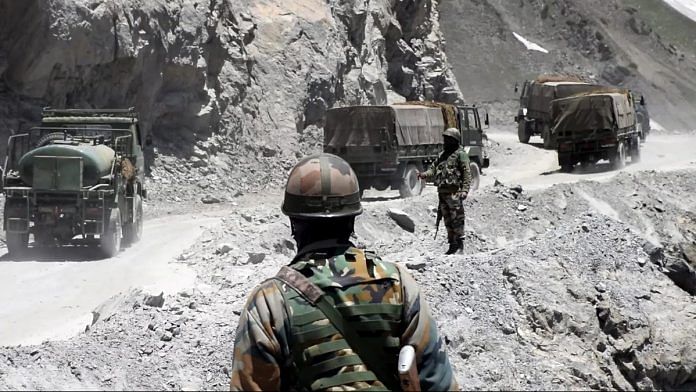
New Delhi: Amid the continuing stalemate with China in eastern Ladakh, and with the proposal for Integrated Battle Groups (IBGs) yet to come into effect, the Army is looking to keep two strike corps for the mountains facing China as part of a larger restructuring plan, ThePrint has learnt.
Defence sources said two existing strike corps — I Corps and 17 Corps — will be slightly restructured to focus on the northern and eastern theatres respectively, to tackle any threat from China. The restructuring is likely to be implemented by this month.
ThePrint reached the Army for an official comment via email, but it said details and implications of force structures cannot be shared.
Also read: Ladakh’s ‘Fire & Fury’ corps gets new commander in Lt Gen PGK Menon amid China tensions
Current structure and realignment
The Army currently has four strike corps — the Mathura-based I Corps, the Ambala-based II corps, the Bhopal-based 21 Corps and the partially-raised 17 Corps. The primary role of a strike corps is offensive trans-border action against an adversary.
A defence source said the I Corps, which was earlier responsible only for the western theatre bordering Pakistan, is now being realigned to also look at the northern theatre.
“Similarly, the Panagarh-based 17 Corps, which is the only existing mountain strike corps, will keep its focus only the eastern theatre,” the source said.
The eastern sector broadly covers Sikkim and Northeastern states’ borders with China. The northern sector broadly covers areas of Ladakh and J&K, while the central sector covers the areas south of eastern Ladakh and the borders that Himachal Pradesh and Uttarakhand share with China.
Currently, the I, II and 21 Corps focus on the western border facing Pakistan, while only the 17 Corps focuses on China. The 17 Corps, sanctioned in 2013, was supposed to have two divisions instead of the regular three, but only the 59 Division now based in Panagarh was raised — the other was among the raisings shelved due to financial constraints. Earlier this year, some elements of the 17 Corps had also been deployed in eastern Ladakh.
The sources said the plan is to get the I Corps to also focus on the northern theatre with two infantry divisions. An armoured division, earlier part of the corps, is likely to be employed as an Army headquarters reserve focusing on the western theatre.
The 17 Corps, meanwhile, will be given an additional division from an existing corps to enhance its capability and focus on the eastern theatre. This will not be a fresh raising, and it is not clear where this division will be based.
The 17 Corps debuted last year in a massive exercise called ‘HimVijay’, which also saw the IBGs concept in action. ThePrint had earlier reported that there are also plans for the 17 Corps to get its own artillery brigade.
Last year, Army chief General M.M. Naravane had said it is expecting a green light from the Union government to set up the first of the IBGs — self-contained, agile, brigade-sized fighting units — at 9 Corps, which is deployed at the western border with Pakistan. However, the plans got delayed due to the Covid-19 pandemic.
A division for central sector too
Sources said the Army is also planning to realign a division from an existing corps to focus exclusively on the central sector with China. This division is likely to be under the central command and will focus on the central theatre, thereby strengthening the offensive options in case of any protracted conflict with China.
“The western theatre is being reorganised in such a way that two strike corps continue to focus on that front with adequate support from the existing holding corps (those deployed for defensive options) to retain the offensive options against Pakistan,” a second defence source said.
The M777 Ultra Lightweight Howitzers — meant for mountainous terrains — will be handed over to the artillery regiments allotted to these formations facing China.
Asked about the need for the restructuring, the source quoted above said the decision is especially critical given that the stalemate with China continues in eastern Ladakh, and talks have been unable to break the impasse.
“After the restructuring comes into place, troops will train according to the new operational tasks and be prepared for contingencies in the mountains in any sector,” the source said.



